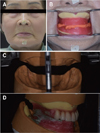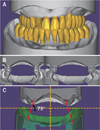This article has been
cited by other articles in ScienceCentral.
Abstract
As the number of elderly population increases, the proportion of edentulous patients is increasing, and the demand for traditional dentures will also increase. Arranging the artificial teeth according to the relationship and shape of the upper and lower alveolar ridge is an important factor increasing the stability of the denture. This case is a 79 year old female patient who wishes to make denture covered by national health insurance for psychological and economical reasons. With the alveolar bone severely atrophic, the dental CAD software was used for accurate diagnosis and the posterior teeth were arranged in a cross bite according to the interalveolar crest line angle by the program. After completion, the denture showed adequate stability and maintenance in periodic examinations and treatment, and the patient also expressed high satisfaction.
Keywords: Complete denture, Digital dentistry, Cross bite
Figures and Tables
Fig. 1
(A) Panoramic radiographic view, (B) Initial intraoral photographs and, (C) Existing prosthesis at first visit.

Fig. 2
(A) Border molding of upper arch for final impression, (B) Border molding and final impression of lower arch using modeling compound.

Fig. 3
Final impression and master cast fabrication. (A) Final impression of maxilla, (B) Final impression of mandible, (C) Master cast of maxilla, (D) Master cast of mandible.

Fig. 4
Jaw relation record and mounting. (A) Vertical dimension, (B) Horizontal relation, (C) Mounted cast. (D) Verification of centric relation bite.

Fig. 5
Captured image of (A) Preliminary teeth arrangement, (B) Cross sectional view on 1st and 2nd molar, (C) Measuring of interalveolar crest line angle.

Fig. 6
Frontal and occlusal views of arranged resin teeth.

Fig. 7
Determining neutral zone with tissue conditioner.

Fig. 8
Photos of occlusal and impression surfaces after finishing of resin processed denture.

Fig. 9
Intraoral photos after delivery of new denture at centric position.









 PDF
PDF ePub
ePub Citation
Citation Print
Print








 XML Download
XML Download